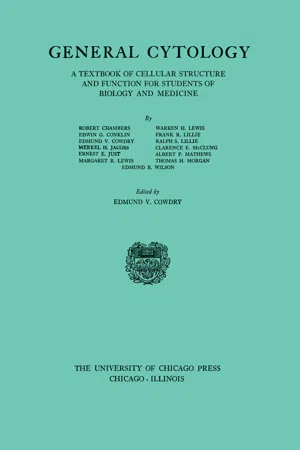Biological Sciences
Cell Diffusion
Cell diffusion is the process by which molecules move from an area of high concentration to an area of low concentration within a cell. This movement occurs through the cell membrane and is driven by the natural kinetic energy of the molecules. Diffusion is essential for the transport of nutrients, waste products, and signaling molecules within cells.
Written by Perlego with AI-assistance
Related key terms
2 Key excerpts on "Cell Diffusion"
- eBook - ePub
General Cytology
A Textbook of Cellular Structure and Function for Students of Biology and Medicine
- Edmund Vincent Cowdry, Edmund Vincent Cowdry(Authors)
- 2014(Publication Date)
- University of Chicago Press(Publisher)
SECTION III PERMEABILITY OF THE CELL TO DIFFUSING SUBSTANCES By MERKEL H. JACOBS University of PennsylvaniaPassage contains an image PERMEABILITY OF THE CELL TO DIFFUSING SUBSTANCES MERKEL H. JACOBS
According to the kinetic theory, molecules, small molecular aggregates, and ions in an essentially liquid medium such as protoplasm, or the various fluids which surround most living cells, have the tendency to become uniformly distributed. This tendency, which is as universal and fundamental as that of heat to flow from a warm to a cool body or electricity from a region of higher to one of lower potential, is utilized by every living cell in securing and distributing materials necessary to its metabolism and in getting rid of waste products. But in no case in a living cell does diffusion proceed in a free and unrestricted manner. Such unrestricted diffusion would soon put an end to that high degree of chemical heterogeneity which is characteristic of all protoplasm and on which life depends. It is a universal property of cells to limit and to modify in a manner which is frequently very complex the diffusion of dissolved substances. The extent of this limitation varies with different cells, with different substances, and with different external and internal conditions, but it is always present, and it is an important task for the physiologist and the cytologist to discover what factors are concerned in determining its characteristic features.The fundamental nature of the problem of cell permeability—using this term in general to cover the penetration of the cell in either direction by diffusing substances—is at once apparent when the activities of any organism are systematically reviewed. Because of their general interest, a number of examples from human and mammalian physiology may be mentioned in this connection, though such examples might equally well be chosen from a variety of other fields.Beginning with the alimentary system, the problem of cell permeability arises in many forms. Why, for example, does practically no absorption, even of water, occur in the stomach, while taking place with the greatest ease in the small intestine? Why, in the latter, are some substances absorbed much more rapidly than others; for example, NaCl more rapidly than Na2 SO4 - eBook - ePub
- R. Michael Akers, D. Michael Denbow(Authors)
- 2013(Publication Date)
- Wiley-Blackwell(Publisher)
Water transport occurs when there is a difference in the relative concentration of water molecules across the membrane. If both sides of a water-permeable membrane are exposed to distilled water, there is no net move of water molecules. Just as many molecules would randomly move in either direction across the barrier. On the other hand, if a substance (solute) were dissolved in the water on one side of the membrane but not the other, the relative number of water molecules per unit volume would be decreased on the side of the membrane with the solute. If the membrane were impermeable to the dissolved substance, but permeable to the water, then water molecules would begin to leave the area with the higher concentration of water molecules and pass across to the opposite side. Movement of solvent in this manner is called osmosis. Figure 2.28 illustrates the effects of membrane permeability on diffusion and osmosis. In the open system illustrated in the figure, differences in osmolality drive the movement of water molecules until hydrostatic pressure becomes sufficiently high to resist the further movement. Movement of water molecules to a region of greater solute concentration can be prevented by applying pressure. The pressure required to prevent migration of solvent molecules is the effective osmotic pressure of the solution. Fig. 2.28. Diffusion and osmosis. The upper panels illustrate the process of simple diffusion. At the beginning (A), two sides of a u-tube are separated by a membrane that is permeable to the solute (red particles) in the left arm of the tube. Over time (B), the solute molecules diffuse down their concentration gradient to areas of lower concentration. With sufficient time, the solute molecules become equally dispersed throughout the entire solution. The lower panels demonstrate osmosis
Learn about this page
Index pages curate the most relevant extracts from our library of academic textbooks. They’ve been created using an in-house natural language model (NLM), each adding context and meaning to key research topics.

